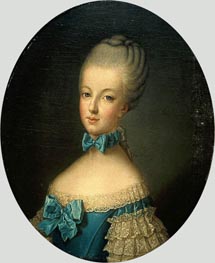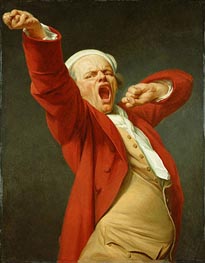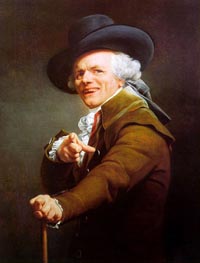
Joseph Ducreux Painting Reproductions 1 of 1
1735-1802
French Rococo Painter
Joseph Ducreux (June 26, 1735-July 24, 1802) was a French portrait painter, pastelist, miniaturist, and engraver. Born in Nancy, Ducreux may have trained with his father, who was also a painter. Ducreux went to Paris in 1760, and trained as the only student of pastelist Maurice-Quentin de La Tour, who specialized in portraiture. In terms of Ducreux's oil technique, Jean-Baptiste Greuze also served as an important influence as his instructor.
Ducreux specialized in portrait painting, and his early portraits were done in pastel, and include those done of the connoisseurs Pierre-Jean Mariette, the Comte de Caylus and Ange-Laurent de la Live de July. These works may have been copies after De La Tour.
Ducreux also made several well-known self-portraits in the late 1780s, including one in which he painted himself in the middle of a large yawn (which currently hangs in the Getty Center), and another of himself guffawing and pointing at the viewer. As evidenced by these self-portraits, Ducreux attempted to break free from the constraints of traditional portraiture. Interested in physiognomy, a pseudoscience based upon the belief that the study and judgment of a person's outer appearance, primarily the face, reflects their character or personality, Ducreux attempted to capture the personality of his subjects –as well as his own- through his warm and individualistic works. Le Discret (ca. 1790), for example, is the portrait of a man asking for silence. His expression is timorous, his finger is pressed against his mouth in alarm as he silently demands discretion or prudence.
In 1769, he was sent to Vienna in order to paint a miniature of Marie-Antoinette before she left the city in 1770 and married Louis XVI of France. Ducreux was made a baron and premier peintre de la reine (First Painter to the Queen) in rewards for his services. Ducreux was given this appointment by Marie-Antoinette even though he was not a member of the Royal Academy of Painting and Sculpture, which had been founded in 1648. The academy was strictly hierarchical and the posts of first painter, ordinary painter and inspector or inspector general of royal factories were customarily reserved for members of the academy.
At the outbreak of the French Revolution, Ducreux traveled to London. There he drew the last portrait ever made of Louis XVI before the king's execution.
Other portraits by Ducreux include those done of Pierre Choderlos de Laclos and Maria Theresa of Austria.
Jacques-Louis David became one of Ducreux's associates when the latter returned to Paris in 1793. David helped Ducreux continue an official career. Ducreux's residence became an informal salon for artists and musicians, who commissioned portraits from him. One of these musicians was his friend Etienne Méhul, who is said to have based the main character of an opera on Ducreux.
From 1760 and from 1762 Ducreux had kept a list of his works but throughout his lifetime, he rarely signed his paintings. Thus, many of his works remain erroneously attributed to other artists.
Ducreux specialized in portrait painting, and his early portraits were done in pastel, and include those done of the connoisseurs Pierre-Jean Mariette, the Comte de Caylus and Ange-Laurent de la Live de July. These works may have been copies after De La Tour.
Ducreux also made several well-known self-portraits in the late 1780s, including one in which he painted himself in the middle of a large yawn (which currently hangs in the Getty Center), and another of himself guffawing and pointing at the viewer. As evidenced by these self-portraits, Ducreux attempted to break free from the constraints of traditional portraiture. Interested in physiognomy, a pseudoscience based upon the belief that the study and judgment of a person's outer appearance, primarily the face, reflects their character or personality, Ducreux attempted to capture the personality of his subjects –as well as his own- through his warm and individualistic works. Le Discret (ca. 1790), for example, is the portrait of a man asking for silence. His expression is timorous, his finger is pressed against his mouth in alarm as he silently demands discretion or prudence.
In 1769, he was sent to Vienna in order to paint a miniature of Marie-Antoinette before she left the city in 1770 and married Louis XVI of France. Ducreux was made a baron and premier peintre de la reine (First Painter to the Queen) in rewards for his services. Ducreux was given this appointment by Marie-Antoinette even though he was not a member of the Royal Academy of Painting and Sculpture, which had been founded in 1648. The academy was strictly hierarchical and the posts of first painter, ordinary painter and inspector or inspector general of royal factories were customarily reserved for members of the academy.
At the outbreak of the French Revolution, Ducreux traveled to London. There he drew the last portrait ever made of Louis XVI before the king's execution.
Other portraits by Ducreux include those done of Pierre Choderlos de Laclos and Maria Theresa of Austria.
Jacques-Louis David became one of Ducreux's associates when the latter returned to Paris in 1793. David helped Ducreux continue an official career. Ducreux's residence became an informal salon for artists and musicians, who commissioned portraits from him. One of these musicians was his friend Etienne Méhul, who is said to have based the main character of an opera on Ducreux.
From 1760 and from 1762 Ducreux had kept a list of his works but throughout his lifetime, he rarely signed his paintings. Thus, many of his works remain erroneously attributed to other artists.
3 Joseph Ducreux Paintings

Portrait of Marie Antoinette de Habsbourg-Lorraine n.d.
Oil Painting
$1539
$1539
Canvas Print
$67.57
$67.57
SKU: DUJ-4323
Joseph Ducreux
Original Size: 64.5 x 53.3 cm
Boston Museum of Fine Arts, Massachusetts, USA
Joseph Ducreux
Original Size: 64.5 x 53.3 cm
Boston Museum of Fine Arts, Massachusetts, USA

Self Portrait Yawning c.1780
Oil Painting
$2105
$2105
Canvas Print
$63.07
$63.07
SKU: DUJ-4324
Joseph Ducreux
Original Size: 117.8 x 90.8 cm
J. Paul Getty Museum, Los Angeles, USA
Joseph Ducreux
Original Size: 117.8 x 90.8 cm
J. Paul Getty Museum, Los Angeles, USA

Self Portrait c.1793
Oil Painting
$1811
$1811
SKU: DUJ-4325
Joseph Ducreux
Original Size: unknown
Private Collection
Joseph Ducreux
Original Size: unknown
Private Collection